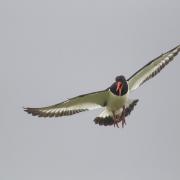Young mammals in search of new territory, burying beetles and subtly-marked moths are just a few of the creatures to look out for this month

As summer slowly fades into autumn many of the mammal populations in Derbyshire are at an annual high.
A long and successful breeding season will see a large number of small mammals leaving their birth places in September and seeking their fortunes elsewhere.
For many this is simply a matter of working their way through the countryside via green highways such as river banks and hedgerows. For some though, especially moles, this is a very precarious process as they may have to come above ground for prolonged periods for the first time in their young lives. The cover of darkness can help, but even then there are keen-eyed predators such as tawny owls looking for their next meal.
The natural habitat can prove daunting enough for these perilous journeys but when a young hedgehog, mole or vole meets a human barrier such as a road or wall, the outcome is often deadly. The risk, however, is worth it, because if these youngsters don’t leave in autumn they will have to compete with other youngsters and adults in a place where food supply and breeding opportunities are limited.

Death is, and has always been, a fundamental part of all natural habitats yet few of us ever spend time investigating what happens to dead birds or mammals. Flies are often one of the first creatures to arrive and lay their eggs on the body of the deceased. However, there are many other insects that play a key role, and one of the most attractive is the sexton beetle.
Sexton beetles can smell death from quite a distance away, up to a kilometre or more. When they arrive, males seek out females and mate on the cadaver. Once this happens the pair will defend the corpse against all other beetles to ensure a good food supply for their young. If it’s a small mammal that has died, they will also sometimes bury the corpse, again helping to offer greater protection for their young. This is not the only amazing fact about these fascinating beetles. After their eggs hatch, the adults stay and help to feed their youngsters, a form of care that is incredibly rare in the insect world. Many naturalists don’t actively seek out small animal corpses, but often come across sexton beetles in the late summer and early autumn because, like moths, they are attracted to light at night.
As autumn slowly sweeps in there might be a few butterflies still on the wing but moth populations, on the other hand, remain buoyant with many species flying strongly at night. One of the most beautiful is the angle shades, a large moth with distinctive markings. There are others that are no less attractive, though much smaller. One example is the bee moth which is small, long, thin and sexually dimorphic (the males and females have different markings). They certainly live up to their name because the caterpillars feed on the combs in bees’ and wasps’ nests. Another striking moth attracted to light that can be found this month is the brimstone and centre barred sallow.
The best way to take up moth watching is to run a moth trap or to join one of the moth nights run by local wildlife groups.

A further group of insects that is at its annual zenith in September is the ladybird beetle. In some years these can reach populations of almost epidemic proportions. Everyone is aware of the classic, red, seven spot ladybird but, unfortunately, more of us are now becoming familiar with its relative, the harlequin ladybird. Initially introduced into Holland to help control aphids on the tulip crop, many harlequins quickly realised that it was quite nice across the channel and flew over. They are now well established in Derbyshire and many people fear what effect this multi-patterned ladybird will have on our British natives.
September is really the end of the bird breeding season. Wood pigeons will still be producing a few late nests and there will still be chicks in the feather-lined, mud nests of some swallows. Most birds, however, particularly species like lapwings that are single brooded, will now be flocking together in preparation for winter. There are many sights that raise the pulse of a bird watcher but few can really rival the coordinated flight of a flock of black-and-white-winged lapwings.
September is not really the start of the fungi season but if we have had a wet summer, such as last year’s, then fungi will start to grow their distinctive toadstools out of the damp woodland soil. Whilst October is the month to explore our fungi-rich woodlands, there is no harm in the second half of September in spending a few days exploring to see if any early species are out.




























